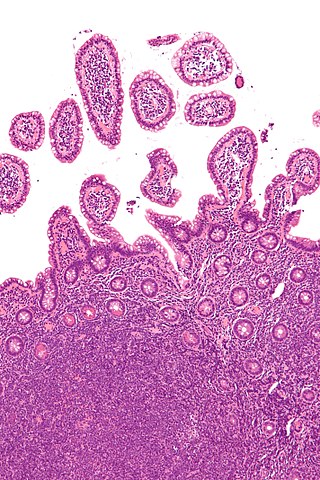
Non-Hodgkin lymphoma (NHL), also known as non-Hodgkin's lymphoma, is a group of blood cancers that includes all types of lymphomas except Hodgkin lymphomas. Symptoms include enlarged lymph nodes, fever, night sweats, weight loss, and tiredness. Other symptoms may include bone pain, chest pain, or itchiness. Some forms are slow-growing while others are fast-growing.

Cyclophosphamide (CP), also known as cytophosphane among other names, is a medication used as chemotherapy and to suppress the immune system. As chemotherapy it is used to treat lymphoma, multiple myeloma, leukemia, ovarian cancer, breast cancer, small cell lung cancer, neuroblastoma, and sarcoma. As an immune suppressor it is used in nephrotic syndrome, granulomatosis with polyangiitis, and following organ transplant, among other conditions. It is taken by mouth or injection into a vein.

Epirubicin is an anthracycline drug used for chemotherapy. It can be used in combination with other medications to treat breast cancer in patients who have had surgery to remove the tumor. It is marketed by Pfizer under the trade name Ellence in the US and Pharmorubicin or Epirubicin Ebewe elsewhere.

Procarbazine is a chemotherapy medication used for the treatment of Hodgkin's lymphoma and brain cancers. For Hodgkin's it is often used together with chlormethine, vincristine, and prednisone while for brain cancers such as glioblastoma multiforme it is used with lomustine and vincristine. It is typically taken by mouth.
MOPP is a combination chemotherapy regimen used to treat Hodgkin lymphoma. The acronym is derived from the component drugs of the regimen:

Dacarbazine, also known as imidazole carboxamide and sold under the brand name DTIC-Dome, is a chemotherapy medication used in the treatment of melanoma and Hodgkin's lymphoma. For Hodgkin's lymphoma it is often used together with vinblastine, bleomycin, and doxorubicin. It is given by injection into a vein.

Fludarabine is a purine analogue and antineoplastic agent. It is generally used as its 5-O-phosphorylated form known as fludarabine phosphate, sold under the brand name Fludara among others. It is a chemotherapy medication used in the treatment of leukemia and lymphoma. These include chronic lymphocytic leukemia, non-Hodgkin's lymphoma, acute myeloid leukemia, and acute lymphocytic leukemia. It is given by injection into a vein or by mouth.
CHOP is the acronym for a chemotherapy regimen used in the treatment of non-Hodgkin lymphoma. CHOP consists of:
Adjuvant therapy, also known as adjunct therapy, adjuvant care, or augmentation therapy, is a therapy that is given in addition to the primary or initial therapy to maximize its effectiveness. The surgeries and complex treatment regimens used in cancer therapy have led the term to be used mainly to describe adjuvant cancer treatments. An example of such adjuvant therapy is the additional treatment usually given after surgery where all detectable disease has been removed, but where there remains a statistical risk of relapse due to the presence of undetected disease. If known disease is left behind following surgery, then further treatment is not technically adjuvant.

T-cell lymphoma is a rare form of cancerous lymphoma affecting T-cells. Lymphoma arises mainly from the uncontrolled proliferation of T-cells and can become cancerous.
ABVD is a chemotherapy regimen used in the first-line treatment of Hodgkin lymphoma, replacing the older MOPP protocol. It consists of concurrent treatment with the chemotherapy drugs:
BEACOPP is a chemotherapy regimen for treatment of Hodgkin lymphoma developed by the German Hodgkin Study Group used for patients in Stages > II or early with unfavorable risk factors. Patients typically receive treatment in cycles of 21 days with no drugs given on days 15–21. There also exists a more intensive regimen with cycles of 14 days. Usually a course of BEACOPP therapy consists of four, sometimes six to eight cycles, or in combination with ABVD. In some countries BEACOPP still is experimental, in others it is a standard therapy. In the United States, ABVD is generally given instead, because BEACOPP is perceived by practicing oncologists to have the potential to induce more secondary neoplasias. However, the final results from the GHSG HD14 trial indicate that "there were no overall differences in treatment-related mortality or secondary malignancies" of BEACOPP relative to ABVD.
An alkylating antineoplastic agent is an alkylating agent used in cancer treatment that attaches an alkyl group (CnH2n+1) to DNA.
Richter's transformation (RT), also known as Richter's syndrome, is the conversion of chronic lymphocytic leukemia (CLL) or its variant, small lymphocytic lymphoma (SLL), into a new and more aggressively malignant disease. CLL is the circulation of malignant B lymphocytes with or without the infiltration of these cells into lymphatic or other tissues while SLL is the infiltration of these malignant B lymphocytes into lymphatic and/or other tissues with little or no circulation of these cells in the blood. CLL along with its SLL variant are grouped together in the term CLL/SLL.

Pixantrone is an experimental antineoplastic (anti-cancer) drug, an analogue of mitoxantrone with fewer toxic effects on cardiac tissue. It acts as a topoisomerase II poison and intercalating agent. The code name BBR 2778 refers to pixantrone dimaleate, the actual substance commonly used in clinical trials.
Hyper-CVAD is a chemotherapy regimen used to treat some forms of leukemia, high-grade non-Hodgkin lymphoma, and lymphoblastic leukemia.

Plasmablastic lymphoma (PBL) is a type of large B-cell lymphoma recognized by the World Health Organization (WHO) in 2017 as belonging to a subgroup of lymphomas termed lymphoid neoplasms with plasmablastic differentiation. The other lymphoid neoplasms within this subgroup are: plasmablastic plasma cell lymphoma ; primary effusion lymphoma that is Kaposi's sarcoma-associated herpesvirus positive or Kaposi's sarcoma-associated Herpesvirus negative; anaplastic lymphoma kinase-positive large B-cell lymphoma; and human herpesvirus 8-positive diffuse large B-cell lymphoma, not otherwise specified. All of these lymphomas are malignancies of plasmablasts, i.e. B-cells that have differentiated into plasmablasts but because of their malignant nature: fail to differentiate further into mature plasma cells; proliferate excessively; and accumulate in and injure various tissues and organs.
IMEP is a chemotherapy regimen that is effective for nasal NK- / T-cell lymphoma. This chemotherapy regimen was also tested in Hodgkin disease as a part of a multidrug alternating scheme COPP / ABV / IMEP. But in that setting it showed no advantage in efficacy and toxicity compared to the use of ABVD or the alternating COPP / ABVD scheme.
EPOCH is an intensive chemotherapy regimen intended for treatment of aggressive non-Hodgkin's lymphoma.
CEPP is a chemotherapy regimen that is intended for treatment of aggressive non-Hodgkin lymphomas. It consists of cyclophosphamide, etoposide, procarbazine, and prednisone. Unlike CHOP, this chemotherapy regimen does not contain doxorubicin or any other anthracycline. Thus, it can be used in patients with severe cardiovascular diseases and contraindications for doxorubicin-containing regimens. This regimen also does not contain vincristine and can be used in patients with neuropathy.








